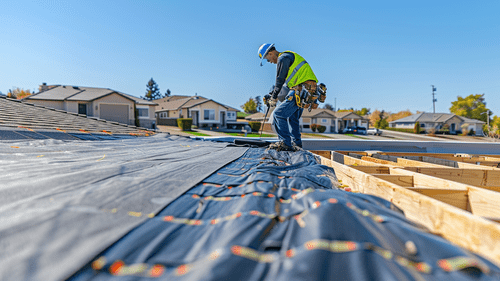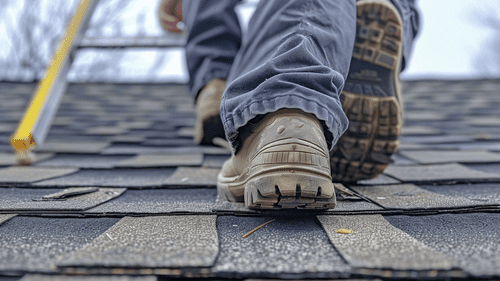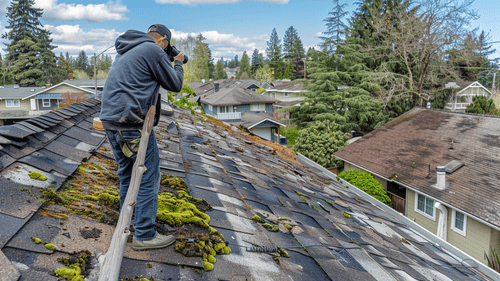Did you know that Texas homeowners faced over $500 million in hail-related roof damage claims in recent years? Most of this costly damage could have been prevented with regular maintenance. Your roof silently protects everything you value, yet it's often ignored until water starts dripping onto your dining table or bedroom floor. By then, what might have been a simple fix has turned into a major expense that disrupts your life and strains your budget.
This seasonal maintenance guide gives you practical steps to defend your home against weather extremes throughout the year. We've broken down essential tasks by season, helping you spot small issues before they become expensive emergencies. Whether you're comfortable handling basic inspections yourself or prefer professional help, this checklist provides a straightforward approach to roof care that protects your investment and gives you peace of mind through every season.
Spring Revival: Post-Winter Inspection and Repair
Winter's harsh conditions can take a significant toll on your roof, making spring the perfect time to assess and address any damage. The freeze-thaw cycles of winter create unique stresses on roofing materials that aren't visible until the snow melts away. As temperatures stabilize, conducting a thorough inspection becomes essential to prevent small issues from developing into costly repairs.
Begin your spring roof revival by examining your roof's overall condition from ground level. Look for obvious signs of damage like missing or displaced shingles, sagging areas, or visible water stains on exterior walls. These indicators often point to more significant problems that deserve immediate attention. For a closer inspection, use binoculars to safely observe roof details without climbing up, which can be dangerous without proper safety equipment.
Ice dam effects represent one of winter's most destructive forces on roofing systems. These ridges of ice form at roof edges when heat escapes from the attic, melting snow that refreezes at the colder eave areas. The resulting ice barrier forces water underneath shingles, causing leaks, interior water damage, and deterioration of roofing materials. Check for signs of ice dam damage including:
- Water stains on exterior walls or interior ceilings
- Damaged or loose shingles, particularly near the roof edge
- Bent or damaged gutters and downspouts
- Peeling paint or rotted wood near the roofline
Gutter system restoration stands as a critical component of spring roof maintenance. Winter debris accumulation can prevent proper drainage, leading to water backup that damages fascia boards and roofing materials. Start by removing all debris from gutters and downspouts, flushing the system with water to verify proper flow. Check for proper gutter slope (about 1/4 inch per 10 feet toward downspouts) and secure any loose gutter fasteners that may have worked free during winter freezes.
Shingle inspection requires careful attention to detail. Winter winds, heavy snow loads, and freeze-thaw cycles can damage or dislodge shingles, creating potential leak points. Look for granule loss (visible as bald spots or granules collecting in gutters), curling edges, cracks, or completely missing shingles. Pay special attention to areas around chimneys, vents, and valleys where water concentrates during snowmelt.
Proper attic ventilation becomes increasingly important as spring temperatures rise. Inadequate ventilation traps moisture and heat in the attic space, potentially causing shingle deterioration from beneath and creating perfect conditions for mold growth. Inspect attic spaces for proper airflow, ensuring both intake vents (typically at eaves) and exhaust vents (at or near the ridge) remain unobstructed. Check for water stains, mold, or compressed insulation, which indicate ventilation problems that require correction.
When considering professional versus DIY spring assessments, safety should always be your priority. Most homeowners can safely conduct visual inspections from ground level and handle basic gutter cleaning with proper ladder safety. However, walking on roofs, replacing shingles, or addressing structural concerns should be left to qualified professionals with proper safety equipment and expertise. The small investment in professional inspection can identify hidden problems before they require major repairs.
Summer Protection: Heat Defense and Storm Preparation
Summer introduces unique challenges to your roofing system, with extreme heat and severe storms creating a dual threat that requires proactive management. The relentless summer sun subjects roofing materials to temperatures that can exceed 150°F, accelerating aging and creating expansion-contraction cycles that stress every component of your roof. Understanding these heat-related vulnerabilities helps you implement protective measures that extend your roof's service life.
Asphalt shingles, the most common residential roofing material, are particularly susceptible to UV damage. The sun's rays gradually break down the oils in asphalt, causing shingles to become brittle and lose protective granules. This degradation accelerates during extended heat waves, making summer an ideal time to assess shingle condition. Look for excessive granule loss, curling edges, or blistering surfaces – all indicators of heat-related deterioration that may require professional attention.
Expansion and contraction represent another significant summer concern. As roofing materials heat during the day and cool at night, they expand and contract, potentially creating gaps around flashing, vents, and other roof penetrations. These temperature-induced movements can loosen fasteners and create entry points for water during summer storms. Inspect these vulnerable areas carefully, looking for separated seams or loose materials that might compromise your roof's water resistance.
Hailstorm preparation becomes crucial during summer months, particularly in regions like Texas where hail-related claims reached $500 million in 2022. While you cannot prevent hailstorms, you can minimize potential damage through strategic preparation. Consider impact-resistant roofing materials during planned replacements, which offer superior protection against hail damage. For existing roofs, ensure all components are properly secured and replace any damaged materials promptly to prevent progressive deterioration during subsequent storms.
"Addressing common roofing problems like leaks, damaged shingles, and inadequate ventilation promptly can save homeowners thousands in potential structural damage and energy costs."
Proper attic temperature management significantly extends roof lifespan during summer months. Without adequate ventilation, attic temperatures can soar above 150°F, literally cooking shingles from below while promoting premature aging. Check that soffit vents remain unobstructed by insulation and that ridge or other exhaust vents function properly. The goal is continuous airflow that removes superheated air before it can damage roofing components or increase cooling costs for your home.
Early leak detection requires vigilance during summer rain events. Even small leaks can cause significant damage over time, promoting mold growth and structural deterioration. After summer storms, inspect interior ceilings for water stains, paying particular attention to areas around chimneys, skylights, and roof valleys. Outside, look for missing or damaged shingles, especially in areas where water concentrates during rainfall. Addressing these common issues promptly prevents minor problems from becoming major repairs.
Energy efficiency checks during summer can reveal opportunities to improve your home's comfort while reducing cooling costs. A properly maintained roof contributes significantly to overall energy efficiency. Consider scheduling a professional inspection that includes thermal imaging to identify areas where heat transfer occurs. For immediate improvement, ensure attic insulation maintains proper depth and coverage, preventing heat from radiating downward into living spaces. Some homeowners may benefit from reflective roof coatings that reduce heat absorption, particularly effective on flat or low-slope roofs.
Fall Readiness: Preparing Your Roof for Winter Challenges
Fall represents your last opportunity to prepare your roof for winter's harshest conditions. As temperatures begin to drop, implementing a comprehensive maintenance plan helps prevent weather-related emergencies during the coldest months. The investment of time and resources during autumn pays dividends in reduced winter damage and extended roof longevity.
Critical gutter maintenance tops the list of fall priorities. Clogged gutters create the perfect conditions for ice dam formation, which forces water beneath shingles and into your home. Remove all leaves, twigs, and debris from gutters and downspouts, ensuring unobstructed water flow across the entire system. Consider installing gutter guards if falling leaves consistently create blockages in your area. Test the system by running water through it, verifying that downspouts direct water away from your foundation and that no leaks occur at seams or connections.
Tree management becomes particularly important before winter arrives. Overhanging branches can break under snow and ice loads, potentially causing significant roof damage during winter storms. Trim branches to maintain a minimum 10-foot clearance from your roof surface, removing dead or diseased limbs that pose the greatest risk during high winds or ice accumulation. This preventative measure not only protects your roof but also reduces debris in gutters and minimizes the potential for moisture retention on roofing surfaces.
Moss and algae treatment should be completed before winter moisture makes removal more difficult. These organisms retain moisture against roofing materials, accelerating deterioration and potentially creating leak points. For light growth, a 50/50 mixture of water and household bleach applied on an overcast day effectively eliminates most moss and algae. More substantial growth may require commercial treatments or professional removal. After treatment, consider installing zinc or copper strips near the ridge, which release metals that naturally inhibit future growth when rainwater flows across them.
Flashing inspection and repair represent critical fall maintenance tasks. Flashing – the metal material that seals roof transitions and penetrations – often develops leaks at seams or attachment points. Inspect all flashing around chimneys, vents, skylights, and roof valleys, looking for signs of separation, corrosion, or missing sealant. Replace damaged sections and reseal as needed using appropriate roofing cement or caulk designed for exterior applications. This relatively simple maintenance prevents the most common winter leak points.
Insulation assessment completes your fall preparation strategy. Proper attic insulation not only improves energy efficiency but also prevents ice dam formation by maintaining a consistent roof temperature. Inspect attic insulation for proper depth (typically 12-15 inches for most climates) and coverage, ensuring no gaps exist near exterior walls. Pay special attention to areas around attic access points, recessed lighting, and ventilation fixtures where insulation often becomes displaced. Adding insulation where needed represents one of the most cost-effective ways to prevent winter roof damage while reducing heating costs.
Winter Vigilance: Ongoing Protection During Harsh Conditions
Winter presents unique challenges for roof maintenance, requiring ongoing vigilance rather than one-time preparation. Heavy snow loads, ice accumulation, and freeze-thaw cycles create constantly changing conditions that demand regular monitoring and sometimes immediate action. Developing a winter roof care strategy helps prevent structural damage while maintaining your home's protective envelope during the harshest season.
Safe snow removal becomes essential when accumulations exceed your roof's designed load capacity. Most residential roofs can support about 20 pounds per square foot of snow, roughly equivalent to 4 feet of fresh snow or 2 feet of packed snow. When accumulations approach these limits, removal becomes necessary to prevent structural damage. Use a roof rake with an extended handle to remove snow while standing safely on the ground, working from the edge upward and leaving 2-3 inches to avoid damaging roofing materials. Never use metal tools or attempt to remove ice, which can damage shingles and create leak points.
Ice dam prevention requires consistent monitoring throughout winter. These destructive ice formations develop when heat escapes from living spaces into the attic, creating roof surface temperature differentials that melt snow at higher points while allowing refreezing at the colder eaves. Check roof edges after snowfalls for signs of ice accumulation, particularly on north-facing sections that receive less sun exposure. For immediate treatment of forming ice dams, fill a nylon stocking with calcium chloride ice melt and position it perpendicular to the roof edge, creating a channel for water drainage. Long-term prevention focuses on proper attic insulation and ventilation to maintain consistent roof temperatures.
Developing emergency repair protocols before problems occur ensures you're prepared for winter roofing emergencies. Keep contact information for qualified roofing professionals readily available, including those who offer emergency services during winter months. Maintain basic supplies for temporary repairs, including roofing cement, spare shingles, plastic sheeting, and weatherproof tape. For interior leaks, place buckets to collect water and use fans to dry affected areas once the leak is addressed. Document all damage with photographs and detailed notes for insurance purposes.
Establishing a winter inspection schedule helps identify problems before they cause significant damage. After major snow events or temperature fluctuations, conduct visual inspections from ground level using binoculars. Look for displaced shingles, sagging areas, ice dam formation, or icicles hanging from gutters (which often indicate blocked drainage). Inside, check attic spaces for signs of water intrusion, paying particular attention to areas around chimneys, vents, and previous repair locations. These regular checks allow early intervention before minor issues escalate into major problems.
Documentation practices play a crucial role in winter roof management. Maintain a detailed log of all observations, actions taken, and professional services performed. Photograph roof conditions after major weather events, creating a visual record that proves invaluable for insurance claims if damage occurs. Save all receipts for snow removal services, emergency repairs, and related expenses, as these may be reimbursable through homeowner's insurance or qualify for tax deductions in certain situations. This systematic documentation creates a comprehensive roof history that supports insurance claims while informing future maintenance decisions.
Creating Your Customized Maintenance Calendar
Developing a personalized roof maintenance calendar transforms reactive emergency repairs into proactive care that extends roof lifespan while reducing overall costs. This systematic approach accounts for your specific regional climate patterns, roof characteristics, and personal capabilities, creating a sustainable maintenance routine that protects your investment throughout the year.
Regional considerations significantly impact maintenance timing and frequency. Homes in Texas and other hail-prone areas need more frequent inspections during spring storm season, while northern climates require greater attention to snow load and ice dam prevention during extended winters. Study your local weather patterns and adjust your maintenance schedule accordingly, emphasizing preventative measures before your region's most challenging seasons. For example, coastal homes should schedule additional inspections before and after hurricane season, while desert dwellings benefit from more frequent checks for UV damage during extreme heat periods.
Digital tools and apps streamline maintenance scheduling and documentation. Home maintenance applications like HomeZada, PocketList, or BrightNest allow you to create customized reminder systems that align with your regional needs and roof type. Many of these platforms include documentation features for storing inspection photos, repair receipts, and contractor information. Some insurance companies also offer policyholder apps that facilitate documentation for potential claims. These digital assistants ensure no maintenance task falls through the cracks while creating comprehensive records of your roof's condition and care history.
Building relationships with trusted roofing professionals enhances your maintenance program's effectiveness. Schedule annual professional inspections during your region's mild weather season, allowing sufficient time to address any identified issues before extreme conditions arrive. When selecting a roofing partner, look for established companies with strong local reputations, appropriate licensing and insurance, and willingness to provide detailed inspection reports rather than immediate sales pitches. The best professionals educate homeowners about specific roof conditions while respecting budget constraints and offering prioritized repair recommendations.
Conducting a cost-benefit analysis of your maintenance program helps justify the investment while identifying the most effective practices. Track all maintenance expenses, including professional inspections, DIY supplies, and preventative repairs. Compare these costs against potential emergency repair expenses, which typically cost 3-5 times more than scheduled maintenance addressing the same issues. This analysis often reveals that comprehensive maintenance programs pay for themselves within 2-3 years while extending overall roof lifespan by 5-10 years – a significant return on investment for most homeowners.
Documentation systems protect your investment while supporting potential insurance claims. Create a dedicated "roof file" containing your original roof warranty, contractor information, material specifications, and all maintenance records. Supplement this information with dated photographs taken during each inspection, creating visual evidence of your roof's condition over time. Store digital copies of all documents in cloud storage for protection against physical damage. This comprehensive documentation not only supports insurance claims but also becomes a valuable asset when selling your home, demonstrating your commitment to proper maintenance and potentially increasing property value.
Safeguarding Your Investment: The Year-Round Approach to Roof Protection
Your roof silently defends everything beneath it, yet proper maintenance often falls to the bottom of homeowners' priority lists. This seasonal guide provides a structured approach to protecting this critical investment throughout the year's changing challenges. From spring's post-winter recovery to summer's heat defenses, fall's winter preparation, and ongoing vigilance during harsh winter conditions, each season demands specific attention to different aspects of your roofing system. By following these season-specific recommendations and creating a customized maintenance calendar tailored to your region and roof type, you'll prevent minor issues from escalating into costly emergencies.
The difference between a roof that fails prematurely and one that exceeds its expected lifespan often comes down to consistent, proactive care. The $500 million in preventable hail damage faced by Texas homeowners underscores the high cost of neglect. Regular inspections, timely repairs, and seasonal preparedness don't just extend your roof's life—they protect everything underneath it, from your family's safety to your home's structural integrity. Remember, your roof doesn't wear out all at once; it deteriorates one ignored problem at a time. What will you do differently this season to ensure your home's first line of defense remains strong for years to come?







